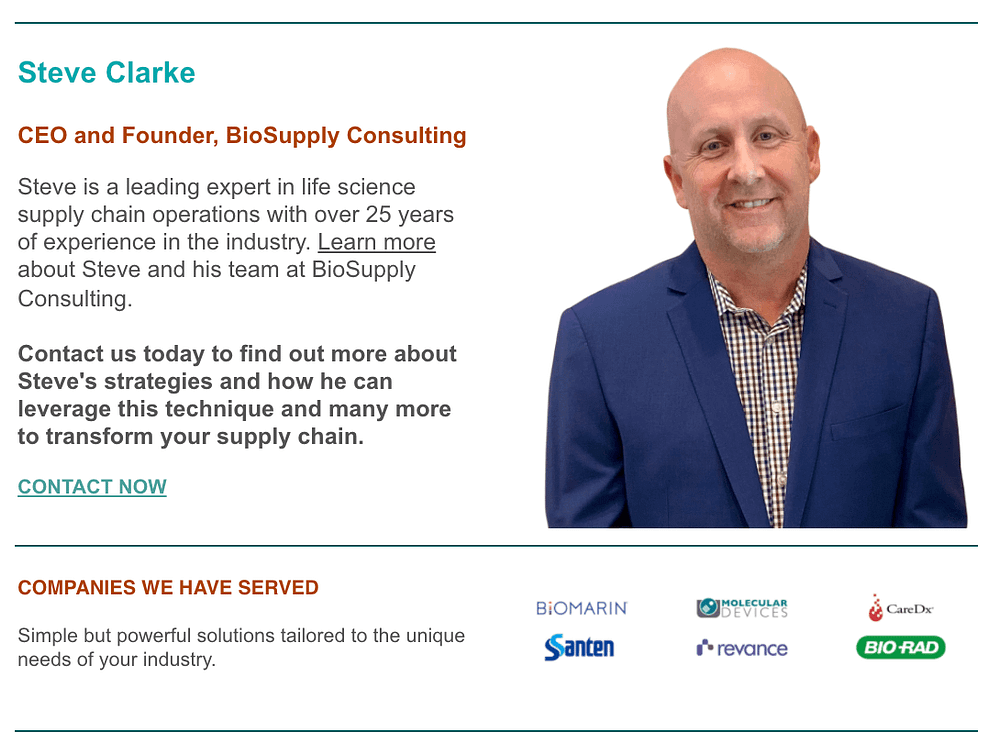LIFE SCIENCE SUPPLY CHAIN SOLUTIONS BY STEVE CLARKE
In a past article, I showed how 4 powerful process redesign principles could be used to transform your supply chain performance. Here I will introduce 3 more principles that you can also leverage to transform your supply chain.
Challenge
Whenever you are evaluating a business process, every step should be challenged.Here are the 3 challenges that we will focus on today: 1. What?Could the step be completely removed from the process? 3. How precisely?Should it be done more precisely, or less? Obviously, more precisely will require more work, but maybe it is justified. On the other hand, if the work can be performed less precisely with the same outcome, then let’s do it! From my experience, life science business processes are much more bureaucratic and inefficient than most industries, primarily due to all of the regulations. This means that this exercise presents more opportunity in life sciences than other industries.
Solution
Let’s look at examples of where steps can either be completely removed, assigned to somebody else, or with a different level of precision to transform the supply chain:
1. What?Example: reduce approval requirements for a PO requisition, so one person, not multiple people are required. 2. Who?Example: ask the supplier to manage replenished of some commodities (VMI). 3. How precisely?Example: Instead of every item having the same safety stock level, calculate the optimal level based on variation in demand and supply lead times.
Testimonial
“Transformed a very “manual” supply chain into an efficient and system-oriented process.”
~Nicolas Huret, Managing Partner at Chevalier Consulting
Results
Here are some real-life examples of how we used each of these three principles at life science clients: What?: Signatures were required for every purchase order. We changed the requirements, so that any purchase order that is required for raw materials to support the production plan does not require a purchase order. Since the production plan was approved during the S&OP process, why spend time approving everything required to support something that has already been approved? Who?: Buyers were placing orders for bulky cardboard boxes, based upon MRP, which was often inaccurate, so they ended up with pallets of excess materials, which was problematic for a small warehouse. We transferred the responsibility of requesting delivery from the supplier for certain items like cardboard boxes, to the material handlers. This made more sense since they could see the ACTUAL inventory levels and not inaccurate MRP messages. Some items very quickly dropped from 60 days on hand to less than a week. How precisely?: The client was attempting to perform detailed capacity planning, and failing miserably. For it to work, many inputs were required, such as work center data, routing data, work order status, planned orders etc. They were unable to accurately maintain all this data, so the capacity plan was inaccurate and therefore the production plan was often unrealistic resulting in late orders and upset customers. Instead, we implemented Rough Cut Capacity Planning (RCCP), which focused instead on only key resources. In addition, the only inputs are the product family production plan and the resources required for an average item within the product family. For example, if the production plan was 1,000 units for the month, and you know on average that it requires 20 standard hours per unit, then you can easily calculate labor requirements. This quickly improved their ability to accurately meet customer order dates.



